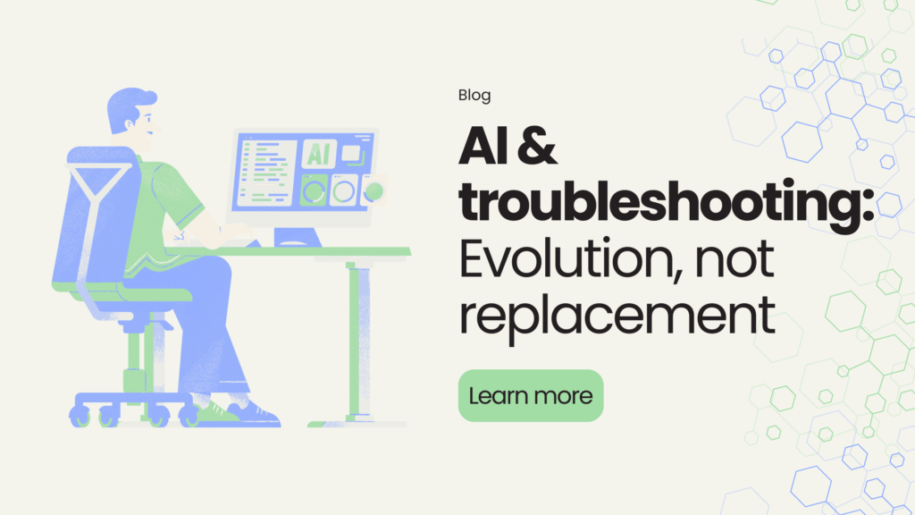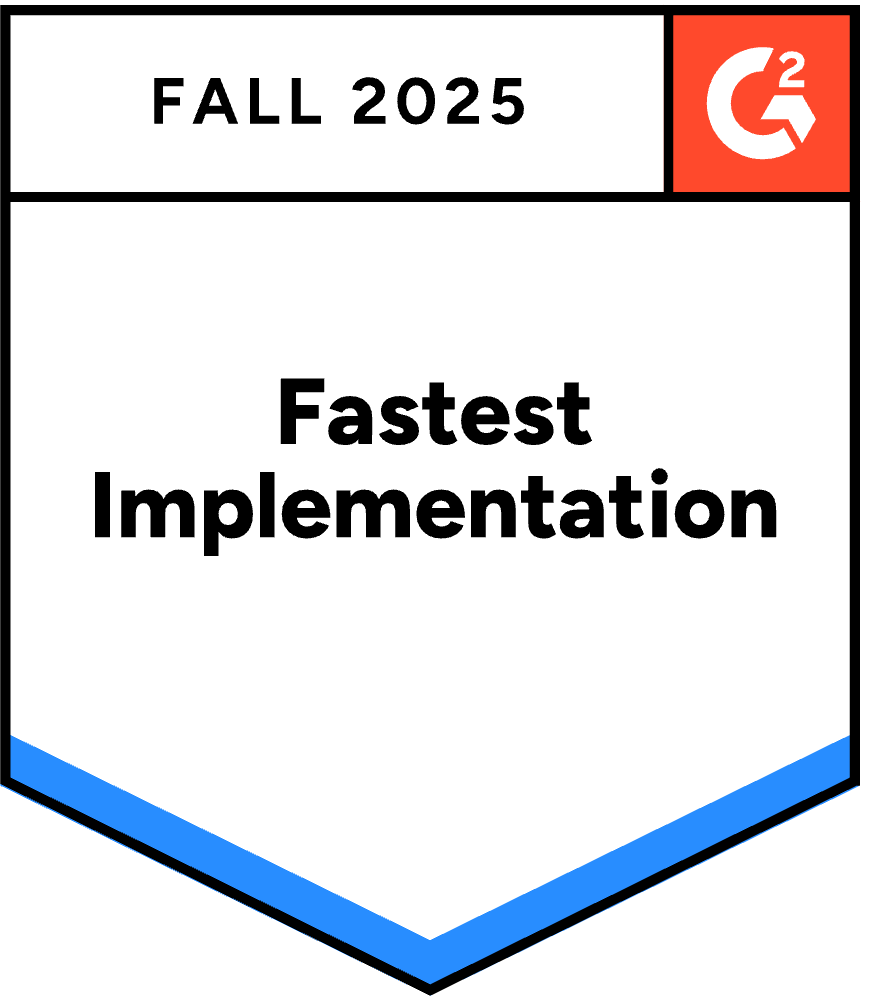Why Are AI and troubleshooting evolving together instead of replacing each other?
As artificial intelligence advances, its impact on Application Performance Monitoring (APM) and observability is undeniable. However, whether AI will entirely replace human troubleshooting is more nuanced than a simple yes or no.
AI excels at:
- Pattern recognition across vast datasets
- Rapid analysis of complex system interactions
- Predictive anomaly detection
- Automated root cause analysis
These capabilities are transforming how we approach troubleshooting, but they’re not rendering human expertise obsolete. Instead, AI is becoming a powerful augmentation tool that enhances human decision-making.
The future of troubleshooting likely involves a symbiosis between AI and human experts:
- AI handles initial triage, filtering out noise and identifying potential issues.
- Human experts interpret AI findings, considering broader context and business impact.
- AI suggests potential solutions based on historical data and the system’s current state.
- Humans make final decisions on corrective actions, especially in high-stakes situations.
This collaboration allows teams to focus on strategic problem-solving rather than getting bogged down in routine diagnostics. It also addresses AI’s current limitations, such as:
- Difficulty adapting to novel situations outside its training data
- Lack of intuition for subtle environmental or organizational factors
- Potential for bias or errors in edge cases
As AI evolves, the balance will shift, with machines handling increasingly complex troubleshooting tasks. However, the need for human oversight, creativity, and accountability in critical systems means that AI is more likely to redefine troubleshooting roles rather than eliminate them.
The key for IT professionals is to embrace AI as a powerful ally in the quest for system reliability and performance while continuously developing higher-level skills that will remain uniquely human.
AI and Troubleshooting: Evolution, Not Replacement
In the rapidly evolving information technology landscape, artificial intelligence (AI) has emerged as a transformative force, reshaping numerous aspects of developing, maintaining, and optimizing systems. Nowhere is this impact more evident than in Application Performance Monitoring (APM) and observability. As AI advances at an unprecedented pace, it raises a critical question: Will AI eventually replace human troubleshooting entirely? As we’ll explore, the answer is far more nuanced than a simple yes or no.
The rise of AI in IT operations
To understand the role of AI in troubleshooting, we must first acknowledge its remarkable capabilities. AI excels in several key areas that are crucial for effective system monitoring and problem resolution:
- Pattern Recognition Across Vast Datasets: AI can analyze enormous volumes of log data, metrics, and system events, identifying patterns and correlations that would be impossible for humans to discern manually.
- Rapid Analysis of Complex System Interactions: Modern IT environments are increasingly complex, with intricate webs of microservices, cloud resources, and distributed systems. AI can quickly map and analyze these interactions, providing insights into system behavior.
- Predictive Anomaly Detection: By learning from historical data, AI can predict potential issues before they occur, enabling proactive maintenance and reducing downtime.
- Automated Root Cause Analysis: When problems arise, AI can swiftly sift through the data to pinpoint the root cause, significantly reducing the Mean Time to Resolution (MTTR).
These capabilities are undoubtedly transforming the landscape of IT operations and troubleshooting. However, it’s crucial to recognize that they are not rendering human expertise obsolete. Instead, AI is emerging as a powerful augmentation tool that enhances human decision-making and problem-solving capabilities.
The symbiosis of AI and human expertise
The future of troubleshooting is not one of replacement but instead of symbiosis between AI and human experts. This collaborative approach leverages the strengths of both artificial and human intelligence:
- AI-Driven Initial Triage: AI systems can continuously monitor vast amounts of data, filtering out noise and identifying potential issues. This allows human experts to focus on genuinely problematic situations rather than being overwhelmed by false positives.
- Human Interpretation and Contextualization: While AI can identify anomalies and suggest potential causes, human experts play a crucial role in interpreting these findings within the broader context of business operations, organizational goals, and subtle environmental factors that may not be captured in data.
- AI-Suggested Solutions: AI can propose potential solutions or remediation strategies based on historical data and the current system state. This can include everything from configuration changes to resource allocation adjustments.
- Human Decision-Making and Implementation: In high-stakes situations, human experts remain essential for final decisions on corrective actions. They can weigh the AI’s suggestions against other factors, including potential business impacts, regulatory considerations, and long-term strategic goals.
This collaborative approach allows IT teams to focus on strategic problem-solving and system optimization rather than getting bogged down in routine diagnostics and alert fatigue. It combines AI’s unparalleled data processing capabilities with human experts’ nuanced understanding and creative problem-solving skills.
Addressing AI’s current limitations
While AI has made remarkable strides in the field of IT operations, it’s essential to acknowledge its current limitations:
- Adaptability to Novel Situations: AI systems are trained on historical data and may struggle when confronted with new scenarios or unprecedented system behaviors. Human experts, on the other hand, can draw on broader experience and creative thinking to address novel challenges.
- Contextual Understanding: AI may lack the intuition for subtle environmental or organizational factors that can influence system behavior. Things like upcoming product launches, marketing campaigns, or even local events can impact system performance in ways that may not be immediately apparent to an AI.
- Bias and Edge Cases: AI systems can inadvertently perpetuate biases in their training data or struggle with edge cases not well-represented in their learning sets. Human oversight is crucial for identifying and mitigating these issues.
- Ethical and Strategic Decision-Making: While AI can provide data-driven insights, it lacks the capacity for moral reasoning and strategic thinking often required in complex troubleshooting scenarios, especially when trade-offs between different business priorities are involved.
The evolving role of IT professionals
As AI continues to evolve, the balance between machine and human involvement in troubleshooting will undoubtedly shift. We can expect AI systems to handle increasingly complex tasks and make more nuanced recommendations. However, the need for human oversight, creativity, and accountability in critical systems means that AI is more likely to redefine troubleshooting roles rather than eliminate them.
IT professionals of the future will need to develop a new set of skills to thrive in this AI-augmented environment:
- AI Literacy: Understanding the capabilities and limitations of AI systems will be crucial for effective collaboration and oversight.
- Data Interpretation: The ability to critically analyze and interpret AI-generated insights will become increasingly important.
- Strategic Thinking: As routine tasks are automated, IT professionals must focus more on strategic planning and optimization.
- Interdisciplinary Knowledge: Understanding the intersection of technology with business strategy, user experience, and even psychology will become more valuable.
- Ethical Reasoning: As AI systems play a more significant role in decision-making, navigating complex ethical considerations will be essential.
Embracing the future of troubleshooting
The key for IT professionals is to embrace AI as a powerful ally in the quest for system reliability and performance. Rather than viewing AI as a threat, it should be seen as a tool that allows human experts to operate at a higher level, focusing on more complex, strategic, and creative system management and optimization aspects.
As we move forward, the most successful IT operations will be those that effectively blend the strengths of AI and human expertise. This symbiotic relationship will drive unprecedented system reliability, performance, and innovation levels.
In conclusion, while AI is undoubtedly reshaping the landscape of troubleshooting and IT operations, it is not a story of replacement but one of evolution and augmentation. Tools like FusionReactor exemplify this shift, integrating AI to enhance, rather than replace, traditional methods. The future belongs to those who can harness the power of AI while continuing to develop the higher-level skills that remain uniquely human. As we navigate this transformative era, we should focus on building collaborative systems that leverage the best of artificial and human intelligence, ushering in a new age of IT operations that is more proactive, efficient, and capable than ever.










